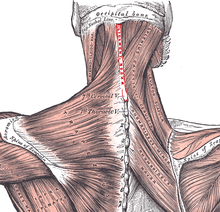Neck tape
The neck ligament ( Ligamentum nuchae ) is a pair of ligaments made of elastic connective tissue , which serves as the back tension of the cervical spine . It can be viewed as a continuation of the supraspinal ligament in the neck area. In most mammals, it extends from the occiput to the spinous process of the seventh cervical vertebra . In dogs , the neck band does not begin until the second cervical vertebra .
The neck band is only slightly developed in humans. It forms a triangular tendon plate, the back edge of which extends between the protuberantia occipitalis externa and the spinous process of the seventh cervical vertebra, while the front edge attaches to the spinous processes of the other cervical vertebrae. It stabilizes the head by elastically counteracting flexion movements of the cervical spine. In addition, it serves the attachment to the adjacent deep neck muscles .
In many animals, the neckband functionally important for the maintenance of normal head and neck position and relieves the muscles of the neck . In horses and ruminants , the neck band is divided into a neck cord ( Funiculus nuchae ) and a neck plate ( Lamina nuchae ) extending vertically to the vertebrae . In ruminants, the neck cord and the front part of the neck plate are paired. The neck band extends backwards to the first thoracic vertebrae and forms the withers cap there . In the horse, too, this is enough, here the unpaired neck band to the fourth thoracic spinal process, where it also forms a withers cap. Cats and pigs do not have a neck band, the neck position is stabilized here purely via the neck muscles, which is why muscle diseases quickly manifest themselves in a lowering of the neck and head.
The withers bursa ( bursa subligamentosa supraspinalis ) lies between the spinous process of the second and third thoracic vertebrae and the ram's cap . In horses can choose between neckband and the first two cervical vertebrae neck bursa ( Bursa subligamentosa nuchalis cranial and caudal ) occur.
Individual evidence
- ↑ a b Richard L. Drake, Wayne Vogl, Adam Mitchell WM: Gray 's Anatomy . Elsevier, Urban & Fischer, 2007, ISBN 978-3-437-41231-8 , pp. 46 .
- ↑ a b c Hermann Bragulla: Anatomy of domestic mammals: Textbook and Color Atlas of study and practice . Schattauer, Stuttgart 2009, ISBN 978-3-7945-2650-5 , p. 106 .
